- Small Business Statistics
Hybrid work research summary. The hybrid work model is a fresh and popular new take on the workweek. During the COVID-19 pandemic, employers and employees alike have recognized the benefits of remote work. The relative success of this unplanned experiment has led to many companies moving towards a permanent hybrid work model. Here are the key hybrid work statistics and the future of work:
-
74% of U.S. companies are using or plan to implement a permanent hybrid work model.
-
44% of U.S. employees prefer a hybrid work model, compared to 51% of employers.
-
63% of high-growth companies use a “productivity anywhere” hybrid work model.
-
55% of employees want to work remotely at least three days a week.
-
Companies’ average IT spending went up 6.7% from 2020 to 2021 as they continued to adjust to their employees working remotely or on hybrid models.
-
59% of employees are more likely to choose an employer that offers remote work opportunities over one that doesn’t.
For further analysis, we broke down the data in the following ways:
Benefits of Hybrid Work Models | Employer Opinions on Hybrid Work | Executive Opinions on Hybrid Work and Company Culture | Employee Opinions on Hybrid Work | Hybrid Work Preferences by Generation | Hybrid Work Trends and Projections
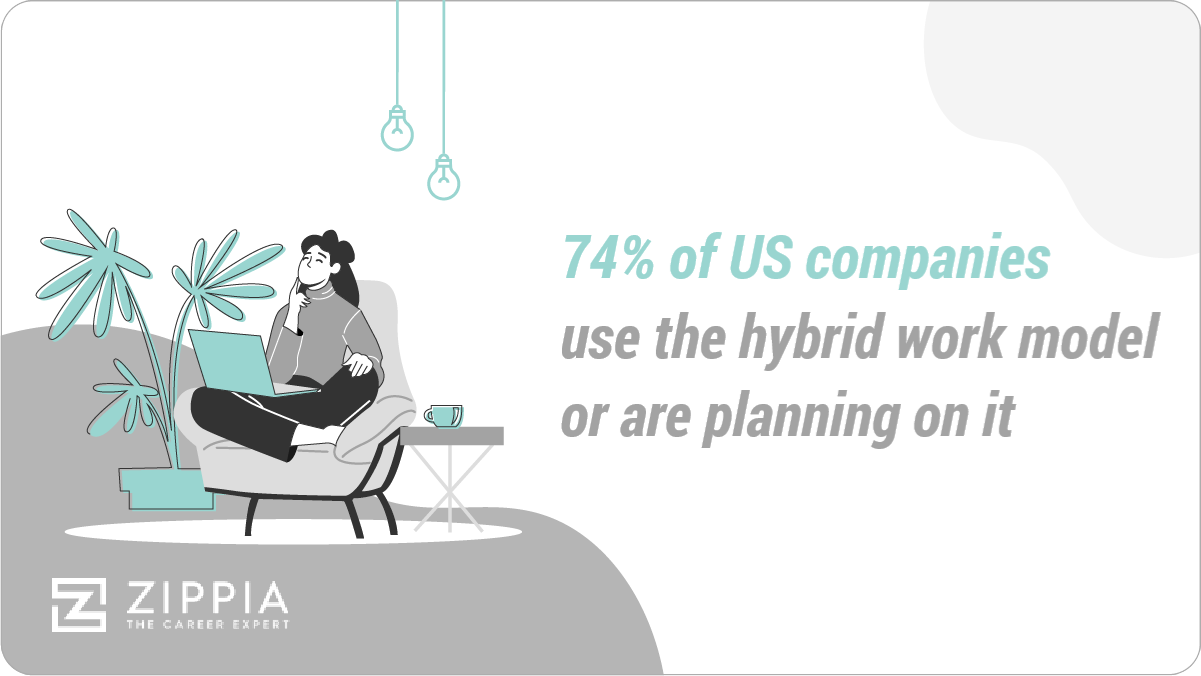
General hybrid work statistics
Hybrid work data is still relatively new, given its very recent surge in popularity. However, even over this short time period, workers and employers already have a lot to say about hybrid work models. To start, here are some general hybrid work statistics:
-
84% of companies said that employee health and wellness was a “very important” consideration in coming up with a work plan.
72% said employee productivity was very important to their decision-making process, 58% said the same of access to talent, and 58% said aligning employees with a corporate mission was a top priority.
Other considerations included diversity, equity, and inclusion, cybersecurity, and real estate, facilities, and technology costs.
-
83% of workers would prefer a hybrid work model in the future.
Of surveyed workers, the ones who were able to use a hybrid model throughout the COVID-19 pandemic were less burnt out than those who worked remotely or in-office 100% of the time, according to an Accenture survey.
-
Companies’ spending on IT has gone up an average of 6.7% from 2020 to 2021.
This is slightly lower than experts were projecting earlier in the year, but spending is only expected to continue to increase throughout 2022 as well.
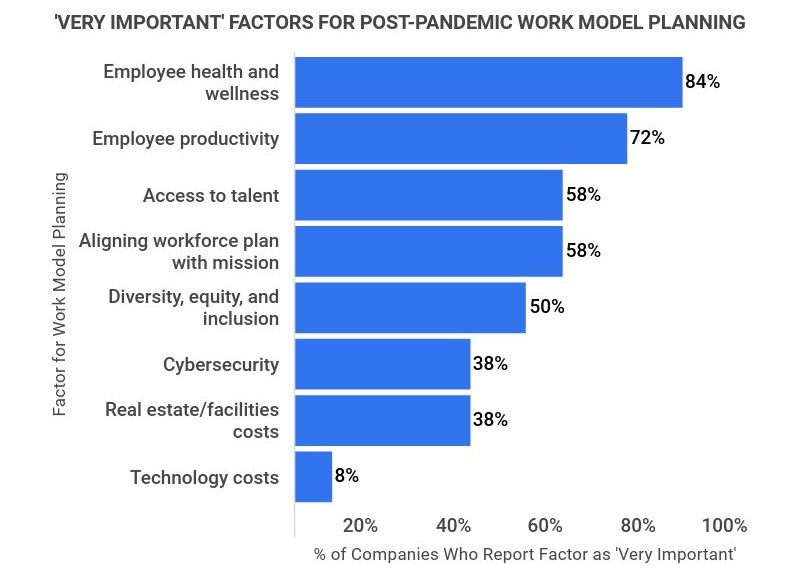
Hybrid work benefits
Hybrid work has many benefits that have been noticed by both workers and employers. From improved turnover to reduced costs, here are some interesting facts about the benefits of hybrid work:
-
On average, companies see a 12% reduction in turnover when they allow their employees to do at least some remote work.
-
54% of employees say they’d leave their current job for one that provides more flexibility, especially in the area of remote work.
-
Companies save $11,000 per year per part-time remote worker, on average.
-
83% of companies say collaboration on new projects has been as good or better than it was before the COVID-19 pandemic when everyone was in the office full-time, according to a study by Statista.
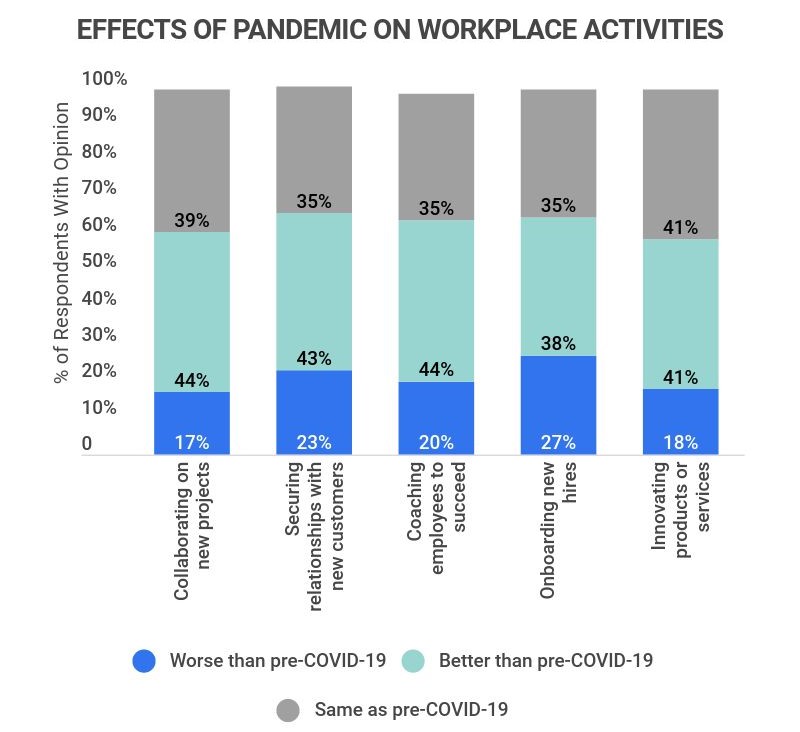
Employer opinions of hybrid work
Hybrid work has become popular with many employers in a short period of time. After all, many were forced to see the benefits of at least partially remote work during the COVID-19 pandemic. To find out more about what employers think of remote work, here are some interesting insights:
-
74% of U.S. companies either are currently using or plan to implement a permanent hybrid work model.
47% of these companies offered a hybrid plan before the COVID-19 pandemic, while 27% have implemented one during the pandemic and plan to make it permanent.
On the other side, 16% of these companies have implemented a hybrid plan since the pandemic but plan to move away from it, and 10% don’t currently offer one and don’t plan to in the future.
-
63% of high-growth companies have implemented hybrid work models.
More specifically, these companies have enabled “productivity anywhere” models, which allow their employees to work remotely or in-office depending on their needs that day.
-
69% of negative or no-growth companies focus on becoming either entirely remote or entirely in-office.
These organizations are spending their time and energy on trying to figure out where everyone should work rather than just allowing employees to set up shop wherever they need to in order to be the most productive.
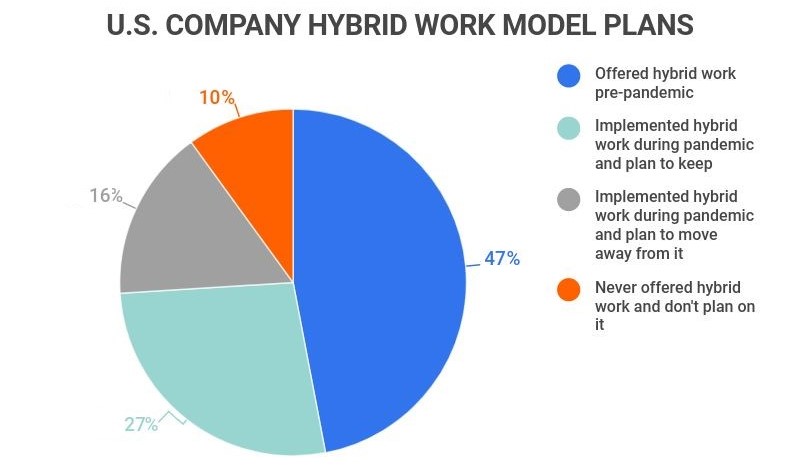
Executive opinions of hybrid work
Many executives aren’t as keen on hybrid work when compared to other employers. Whether they’re concerned about maintaining company culture or keeping up productivity, here are the opinions of executives on hybrid work:
-
The majority (29%) of surveyed executives believe that employees need to spend three days per week in the office in order to maintain company culture.
In comparison, 21% said that employees needed to be present all five days in order to maintain a sense of culture, and 18% said they needed to be in the office for four days. Only 5% said that they don’t need to be in the office at all.
-
65% of executives believe that having employees work in an office is very important to increasing employee productivity.
This is the top reason executives listed when asked about the importance of the office, followed by having space to meet with clients, enabling employees to collaborate well, and creating and maintaining company culture.
-
68% of executives say they and their organizations don’t have a detailed plan in place for a hybrid work model, even though most intend to implement one.
More specifically, 4% haven’t hardly started the planning process, 32% are still discussing it, and another 32% have a high-level vision in place but are still hammering out the details within the C-suite.
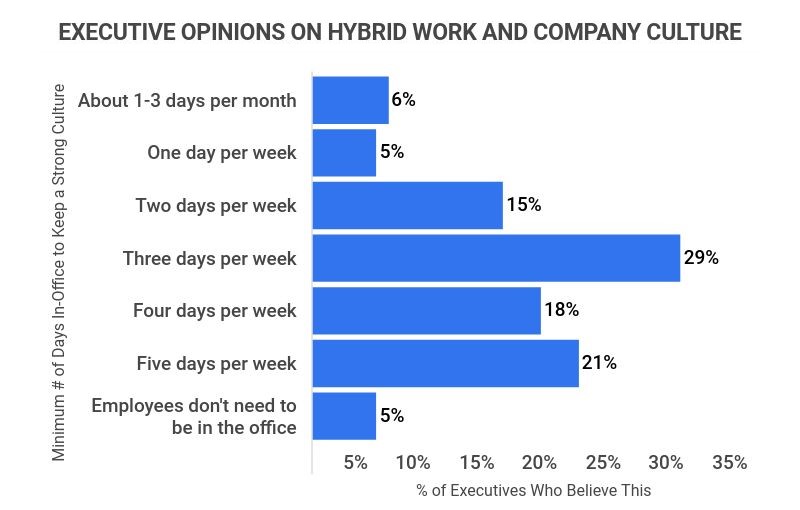
Employee opinions of hybrid work
Most employees enjoyed the benefits of remote work, and may see hybrid work as a perfect compromise post-Covid. Here are the opinions of employees on hybrid working models:
-
84% of employees say that not having a commute is a top benefit of working remotely, according to a survey by Bloomberg.
In addition, 75% of employees say that cost savings is a major benefit of working from home, and over a third of them said they save over $5,000 each year by working remotely.
Other benefits of remote work included a lack of COVID-19 exposure (32%), not having to be away from family members or pets (26%), and having reduced childcare needs (15%).
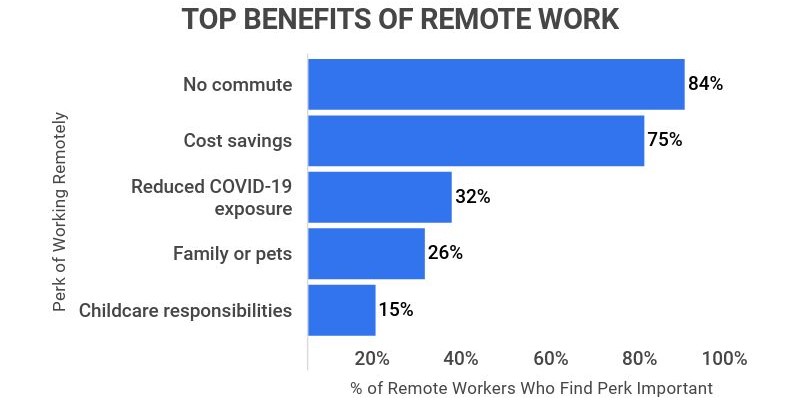
-
87% of employees believe working in the office is important for collaborating and building relationships with team members.
These are also the top needs that employees have for the office, suggesting that if those needs aren’t being met by having an office to work in, workers would see little to no reason for being there.
Other reasons employees believe the office is valuable is to securely access equipment or documents, meet with clients or colleagues, and receive training and participate in career development opportunities.
-
55% of employees say they’d prefer to work remotely at least three days a week.
This data was collected in January of 2021 and is a slight reduction from 59% who said the same in June of 2020, showing that employees may be missing some of the aspects of working in an office.
This is also in opposition to the 68% of employers who believe that workers need to be in the office at least three days a week in order to maintain company culture.
-
30% of employees with less than five years of experience want to work remotely no more than one day a week.
Just 20% of respondents as a whole said the same. 34% of these less experienced employees also feel like they’re less productive when they work remotely (versus 23% of all surveyed workers), likely because they often don’t have as much confidence or autonomy in their roles as more experienced employees do.
-
87% of employees who have the option to work remotely do so at least one day a week.
Here is the breakdown of the average number of days per week employees with the chance to work remotely take advantage of this option:
Number of days worked remotely per week by employees given the option to do so
Days Per Week Percentage of Employees Able to Work Remotely No Days 13% One Day 13% Two Days 18% Three Days 16% Four Days 10% Five or More Days 32%
Hybrid working statistics by generation
Generation can also have an impact on worker opinions of hybrid work. In general, younger generations are more in favor of hybrid work, while older generations have their reservations. Here are the facts:
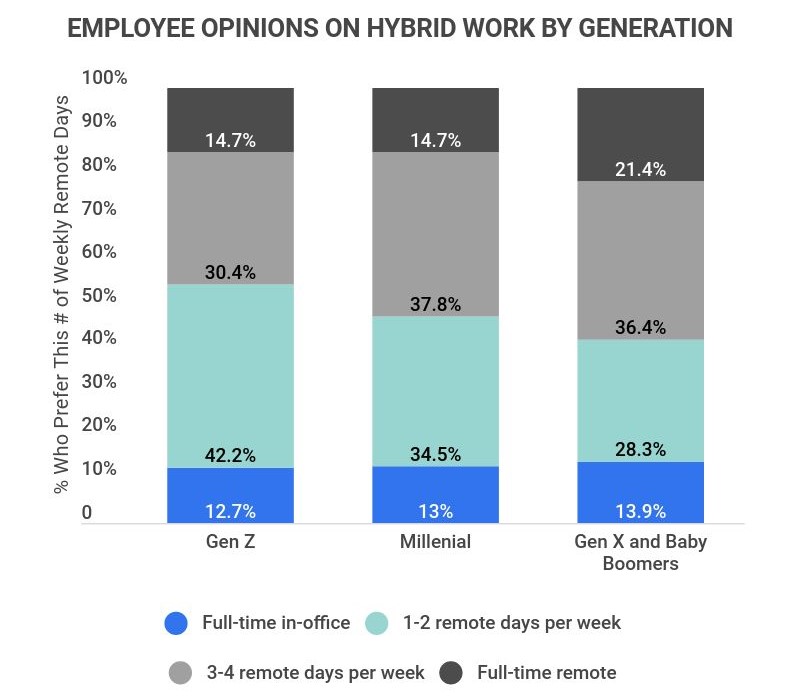
-
42.2% of Gen Z wants to work remotely one to two days a week.
Just 34.5% of Millennials and 28.3% of Gen X and Baby Boomers say the same.
-
37.8% of Millennials want to work remotely three to four days per week.
This is the majority when compared to 30.4% of Gen Z and 36.4% of Gen X and Baby Boomers who say the same.
-
21.4% of Gen X and Baby Boomers want to work remotely full-time.
In comparison, only 14.7% of Millennials and 7.4% of Gen Z want the same.
-
Millennials’ top reasons for wanting an office space are collaboration and internal meetings.
64.2% of Millennials say they want it for collaboration and 61.5% want an office space for internal meetings. They want office spaces to be used for these activities more than any other generation represented in this survey does.
-
Gen Z wants to use office spaces for regular desk work and training and development more than any other age group.
Gen Z wants the office to be used for team culture, team socials, and events, but not much more than the other generations do. In their desire for an office to be used for regular desk work and training and development, however, they far outpace the other age groups.
51.1% of Gen Z wants an office for regular desk work as opposed to 40% of Millennials and 36.4% of Gen X and Baby Boomers, respectively. As far as training and development goes, 48.9% of Gen Z wants an office for this, as opposed to 40.1% of Millennials and 37.4% of Gen X and Baby Boomers.
-
Gen X and Baby Boomers want to use office space for client meetings more than any other generation represented.
49.2% of Gen X and Baby Boomers said they want to use the office for this reason, as opposed to 42.9% of Millennials and 37.1% of Gen Z who say the same.
Hybrid work trends and projections
Hybrid work will likely grow more popular as companies test out their new hybrid work models. To explore the future of hybrid work, here are some essential trends you should know:
-
72% of companies plan to invest more in tools for virtual collaboration in the future.
This shows that organizations are planning to not only continue their remote and hybrid work programs, but also improve them.
In addition, 70% plan to invest in IT infrastructure to secure virtual connectivity, 64% plan on providing more training for managers on how to manage a virtual workforce, and 57% aim to spend money on conference rooms with enhanced virtual connectivity.
Other areas companies are looking to invest in include hoteling applications, communal space in offices, and unassigned (or hoteling) seating in offices.
-
In December of 2020, 52% of employers said they felt they were more productive working remotely, versus 44% who said the same in June of 2020.
The percentage of employers who said their employees were more productive since going remote went from 28% in June of 2020 to 34% in December of 2020.
This shows that the more companies and workers have gotten used to working remotely and invested in technology and systems to make it go more smoothly, the more productivity has increased.
-
The number of online job searches for remote positions increased 460% from June 2019 to June 2021.
The searches were for a wide variety of fields, showing that the preference for remote work isn’t limited to a few industries.
The increase didn’t increase much after June 2021, but it hasn’t decreased either.
Hybrid work model statistics FAQ
-
A hybrid work model is a setup where employees work partially in the office and partially remotely. For some organizations, this means each employee works a few days in the office and a few days at home, while for others it means that some employees work entirely in the office and others work entirely at home.
However it may look, a hybrid work model gives employees the flexibility they desire while still giving them the perks of office spaces such as the ability to interact face-to-face with coworkers and clients.
This model also generally saves companies money since they don’t have to invest as much in their office spaces and their employees are happier, which results in an increase in productivity and a decrease in turnover.
In addition, having employees in the office at least part of the time allows companies to maintain their culture and managers to support their employees more effectively.
-
What percentage of employees want a hybrid work model?
83% of U.S. employees want a hybrid work model. Throughout the COVID-19 pandemic, workers have realized that they’re less likely to burn out if they split their time between home and the office.
Those who work remotely full-time often miss the human interaction of the office, and those who only work in the office typically wish for more flexibility to take care of their personal lives.
As a result, employees have discovered that a hybrid model where they work in the office a few days a week or as needed is the best of both worlds, and companies often agree.
-
What are the advantages of hybrid working?
The advantages of hybrid working are increased flexibility, opportunities for collaboration and professional development, and decreased costs, to name a few.
With a hybrid work model, employees get valuable flexibility while still being able to socialize with their colleagues and access professional development resources in person. They can also access equipment and have professional meeting spaces where they can meet with colleagues and clients. In addition, they save on commuting and even childcare costs.
Hybrid models save companies money too: An average of $11,000 per worker per year, actually. Organizations are also able to keep their employees happy by providing remote work options while still creating their company cultures by having workers in the office at least part of the time.
-
Does hybrid work increase productivity?
Yes, hybrid work increases productivity when it’s implemented thoughtfully. The fact that 63% of high-growth companies embrace hybrid work models, compared to 69% of low- or no-growth companies that embrace 100% remote or in-office options, points to hybrid work being the best system for maximizing productivity, as measured by revenue growth.
Experts point to a combination of increased comfort with remote work, better work-life balance, and the sustained company culture provided by some in-office days as reasons why the hybrid work model is good for productivity.
-
How do you make a hybrid work model work effectively?
To make make a hybrid work model work effectively, it’s necessary to ensure that employees and management are on the same page regarding the amount of time spent in-office, as well as the purpose of that time.
Additionally, everyone needs to be trained on the effective use of virtual tools to ensure as little friction as possible when collaborating on work that is split between remote and in-office workers. Finally, open communication should be encouraged and solicited by management in order to improve hybrid working conditions in whatever way best suits your team.
Conclusion
With the COVID-19 pandemic came a rise in remote work, which employees and companies alike quickly realized had both pros and cons. As organizations are opening up their offices again, many have adopted a hybrid work model either as a temporary measure or a permanent fixture.
83% of employees would love for these models to be the new normal, and 55% want the hybrid to include working from home at least three days a week.
74% of companies agree with their workers that a hybrid model would be beneficial, but executives are split on how many days should be spent in the office, with the majority believing that at least three days a week would be best.
All in all, though, it appears that the hybrid work model is a good idea for businesses, as 63% of high-growth organizations use one, and 69% of negative or low-growth companies do not.
References
-
CNBC. “The Latest Numbers on How Many Workers will be Returning to Offices, and How Often.” Accessed on October 28, 2021.
-
Accenture. “The Future of Work: A Hybrid Work Model.” Accessed on October 28, 2021.
-
Wikibon. “CIOs Signal Hybrid Work Will Power Spending Through 2022.” Accessed on October 28, 2021.
-
Forbes. “5 Proven Benefits of Remote Work for Companies.” Accessed on October 28, 2021.
-
Statista. “How Would You Describe How Effective Your Company Has Been at Performing The Following Activities with Employees Working Remotely?” Accessed on October 28, 2021.
-
Mercer. “Global Survey #8: In the United States, How Are Companies Addressing Flexibility, Inclusivity and the Continued Impact of the Pandemic.” Accessed on October 28, 2021.
-
Bloomberg. “Employees are Quitting Instead of Giving Up Working From Home.” Accessed on October 28, 2021.
-
PWC. “It’s Time To Reimagine Where and How Work Will Get Done.” Accessed on October 28, 2021.
-
McKinsey Company. “What Executives are Saying About the Future of Hybrid Work.” Accessed on October 28, 2021.
-
Hubble. “Gen Z and Millenials are Much More Pro-Office Than Gen X and Baby Boomers.” Accessed on October 28, 2021.
-
Statista. “How Do You Plan To Change Investment Levels, if at all, in the Following Areas?” Accessed on October 28, 2021.
-
CNBC. “Pandemic Pushes Search for Remote Jobs Up 460%.” Accessed on October 28, 2021.
-
Accenture. “The Future of Work: Productive anywhere.” Accessed on February 6, 2022.
-
McKinsey. “Americans Are Embracing Flexible Work — And They Want More of It.” Accessed on February 20, 2023.
- Small Business Statistics








